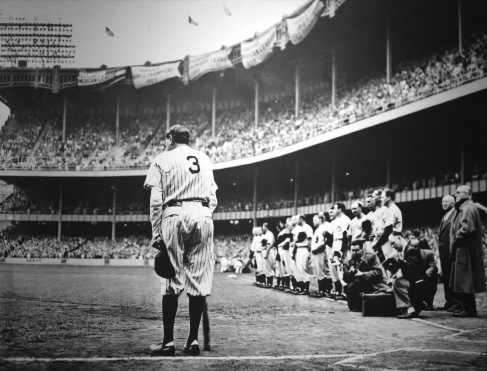“Babe Retires No. 3” is a Pulitzer Prize winning photograph shot by Nat Fein of the New York Herald Tribune in 1949. This photograph is one of my favorite Pulitzer Prize winners of the past century for several reasons; the excellent photographic elements it displays and the story and emotion it successfully delivers.
The first and foremost photographic component this piece demonstrates in excellent form is framing. The framing of Babe Ruth maintains him as the focus and forefront of the photograph but also captures the magnitude of the event through the rest of the photo. It allows the photographer to include the number three on his back, which is highly relevant and ultimately completes the photograph and still capture the large audience that has gathered to witness this ceremony. At first glance, that was what first caught my eye and impressed me. The photographers ability to frame and make Babe the center of the piece, yet still capture the enormity of the occasion.
The next photographic element this piece succeeds in demonstrating is its use of the rule of thirds. It appears quite obvious the photographer has cut the image into three different sections and placed Babe Ruth directly on one of the intersections creating a power point. More specifically, he has placed him on the left side of the photo on this intersection, as apposed to leaving him centered. This creates much drama in the photograph by contrasting Babe with the enormous crowd that has gathered to witness this event. Additionally, I believe it makes for a more aesthetically pleasing photograph.
Another quality this photograph displays quite well is depth of field. Depth of field is the zone in which the camera sees things in as being in focus. Anything outside of this is seen as out of focus. The area that is in focus is the centerpiece of the photo. In this particular case the central area in focus is Babe Ruth, the subject of the piece. Although this is important we should not discount the important role the area that is out of focus plays. It is this part of the photograph that gives the photo depth. Moreover, it is the depth of the photo that gives us an idea of the magnitude of the event and a sense of how many people attended this record day.
Although this photograph is over sixty years old and still is black and white it is an excellent display of exposure. This is displayed in the end product of the image. Just as with any photograph in which you are trying to produce a superb image it is imperative that the photo be well exposed. Despite modern standards of photography, which may discount the quality of exposure and the end product of this photograph, we must remember that for the time period and the given technology this a very well exposed photo.
Aside from the various first-rate technical aspects that “Babe Retires No. 3” provides a viewer it also lends a tremendous story. In my opinion one of the most impressive points of this photo is its ability to capture the spirit and the story of Babe Ruth’s magnificent career. In this shot it depicts the magnitude of the event and also manages to summarize his career his legendary career all in one frame. I firmly believe the story that this photograph tells is what makes this photo a Pulitzer Prize winner and distinguishes it from other sports photos of its kind.
Additionally, the emotions this photo evokes are another important characteristic. This may not be true to all, but for an avid baseball fan like myself this photo raises emotion because it is a tribute to the greatest man to have ever played the game.
It is discernible that this photograph has been taken with a wide-angle lens with a broad field of view to capture all that is necessary to complete this magnificent photograph.
In conclusion, “Babe Retires No. 3” is one of the great photographs of the 20th century because of the exceptional photographic elements it displays and the story and emotion it provides. It was a pleasure and an honor to be able to critique this outstanding Pulitzer Prize winning photograph.
